May 29, 2020
 by Mara Calvello / May 29, 2020
by Mara Calvello / May 29, 2020
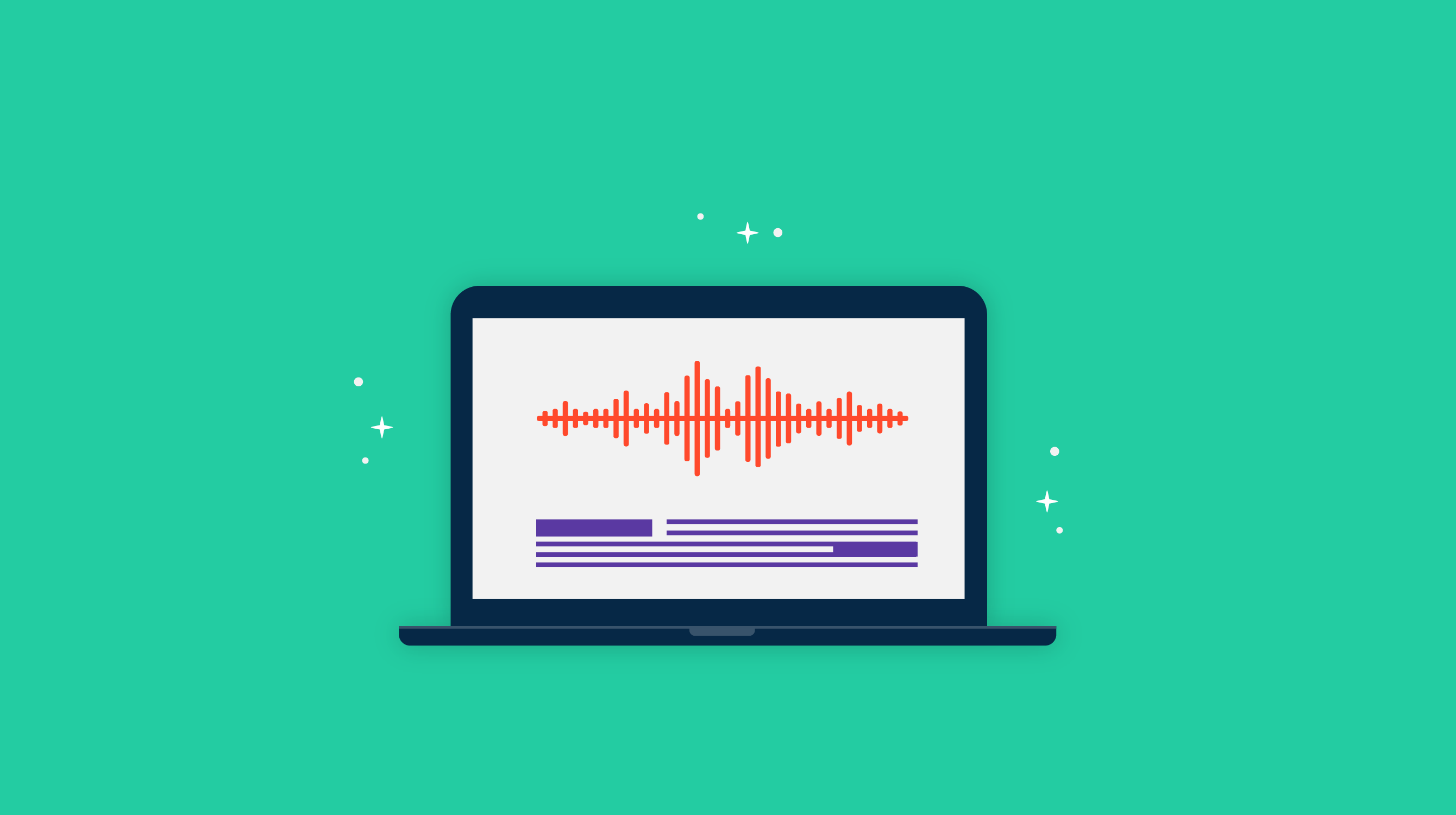
What’s something you need to have to enjoy your favorite movie?
While you might say a bowl of popcorn or your favorite candy, for some, the answer is entirely different: an audio description.
An audio description, otherwise known as a video description, is the additional audio track that describes and gives context to essential visual information in media and live performances. They are typically for consumers who are blind or visually impaired so that they can understand and enjoy the content.
Having an audio description provides additional information on the visual media that is considered essential for being able to understand the content. When this isn’t provided, blind and visually impaired individuals are unable to understand and enjoy the media to its fullest potential.
No matter what type of visual media you’re creating, whether it be a corporate training video, a live performance, or a Hollywood movie, it’s important to make sure that everyone can experience it and understand what’s happening. That’s where having an audio description comes into play.
Three main types of audio descriptions are used in the industry that can be added to your visual media to ensure it can be enjoyed by everyone.
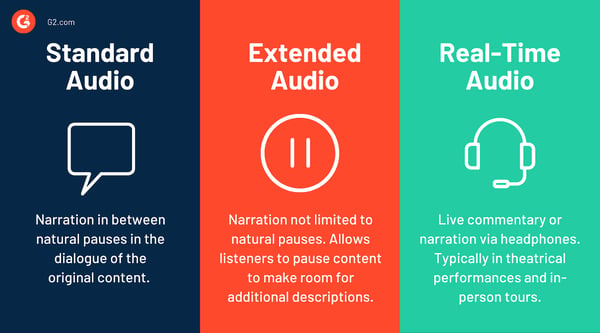
Unsure of which to use? Standard audio description works well for content with frequent pauses or when a small amount of detail needs to be described.
An extended audio description is ideal when lengthier descriptions and key visual information cues need to be described. If you need an audio description for a theatrical performance, in-person tours, or other live events, go with real-time audio.
There are many benefits that you may not realize to including an audio description within your video or other visual media.
According to the CDC, 12 million people in the United States who are over the age of 40 have a vision impairment, including the 1 million people who are completely blind.
Audio descriptions in media allow visual and entertainment content to be accessible for all consumers who are visually impaired.
Another benefit of audio descriptions is the flexibility it provides to viewers interested in experiencing videos and other media in an eyes-free environment. This means that viewers can understand visuals that are happening without being tied down to one place.
This is becoming a growing trend as people are listening to movies and television shows with the audio descriptions turned on, which allows them to experience their content similar to an audiobook while they’re cooking, driving, or doing other household related tasks.
Audio descriptions also aid in the development of two important groups of people: those on the autism spectrum and children.
Individuals with autism often find that listening to audio descriptions paired with visuals helps them understand the emotional and social cues that are demonstrated through actions and facial expressions. Thanks to the narration of visual elements within media, audio descriptions can help identify emotions that those with autism may find difficult to pinpoint or understand.
Children can also benefit from audio descriptions as they develop their language skills. As they begin to associate words with certain actions and behaviors, audio descriptions can be a useful tool to enhance language development and introduce new vocabulary.
The brain processes information either visually or auditorily, which is why you hear people say they’re visual learners or that they learn better when they hear specific information.
For those who gravitate towards auditory learning, audio descriptions can be a helpful aid when retaining new information in an educational setting.
of the population is made up of auditory learners who say they absorb information best through their sense of hearing.
Source: StudyingStyle
There’s no denying that adding audio descriptions to your content brings many benefits. While some would argue that adding it is simply the right thing to do, several anti-discriminatory laws require it.
In the United States, four main accessibility laws require an audio description to accommodate and offer access to those who are blind or who have low vision.
The Americans with Disability Act, also known as the ADA, became law in 1990. This anti-discriminatory law includes a statement that calls for “auxiliary aids” in communication. This applies to those who are blind or have low vision and means that audio descriptions need to be provided.
Within the act are two titles that break this down:
These have since been revised to include online-only businesses, like Netflix and Hulu.
Passed in 1973, the Rehabilitation Act, also known as the Rehab Act, prohibits discrimination based on disability in programs conducted by federal agencies, in programs receiving federal financial assistance, in federal employment, and the employment practices of federal contractors.
Within this act are two sections highlighting closed captioning and web accessibility requirements that impact video accessibility:
In October 2010, President Barack Obama signed the 21st Century Communications and Video Accessibility Act (CVAA). This Act requires modern communication technologies to be made accessible to all people regardless of vision and/or hearing loss.
The goal of this act is to phase-in requirements for audio descriptions between 2010 and 2020. The original roll-out of this act stated that CBS, NBC, ABC, USA, Fox, Disney Channel, TNT, TBS, and Nickelodeon each must provide 50 hours of video-described prime time or children’s programming per calendar quarter by 2012.
This expanded to 60 other TV markets in July 2015 followed by another increase in markets in July 2018. By the end of 2020, 100% of television programming will have audio description available to viewers.
Otherwise known as WCAG, the Web Content Accessibility Guidelines, which is the international standard for web accessibility, requires audio descriptions for time-based media.
Essentially, documents within this law explain how to make web content more accessible with disabilities. It also requires audio descriptions to be provided for those who are blind or have low vision.
There are three levels of requirements within the guidelines:
Whether your visual media is for educational purposes or it’s strictly for entertainment, there are certain quality standards and requirements you should set for your audio description.
Just like the FCC has specific requirements for closed captioning on videos for those with hearing restrictions, the DCMP has a list of guidelines for how to best describe the content.
For instance, it’s important to only describe what is being seen, meaning only what is physically observable. Audio descriptions should never provide a listener with assumptions, opinions, or conclusions. Stick to crucial information only, especially in regards to understanding and comprehending new information.
For example, when providing an audio description of a theatrical performance, you could ask yourself the following questions when writing the audio description:
You want to focus on what is essential for the listener to know in terms of plot development and the characters on screen or on stage. You never want to confuse the listener or infer the dialogue taking place.
Some key standards you should set for yourself when writing audio descriptions are:
According to the World Wide Web Consortium, there are several ways that you can add audio descriptions to visual-based media that comply with the WCAG.
One of the best ways to truly understand what an audio description is and what they can sound like is by listening to examples. Below are audio descriptions within popular and well-known movies.
When the original Frozen trailer came out in 2013, Disney made sure to be as inclusive as possible by releasing one that featured an audio description.
Sticking with the Disney theme, below is the iconic circle of life scene from The Lion King with an audio description.
Fans of Harry Potter can enjoy the opening scene of the final movie mixed with an audio description.
When you’re looking to add audio into a media file, it’s important to edit the audio to make sure it’s high quality and that there aren’t any disruptions to the flow of the sound. Audio editing software is your best bet of doing so in a smooth and seamless way.
* Below are the top five leading audio editing software solutions from G2’s Spring 2020 Grid® Report. Some reviews may be edited for clarity.
Adobe Audition is one part of Adobe's Creative Suite of software products. This professional audio workstation allows users to create, mix, design sound effects, record, and restore audio. Audition is a comprehensive toolset that includes multitrack, waveform, and spectral display.
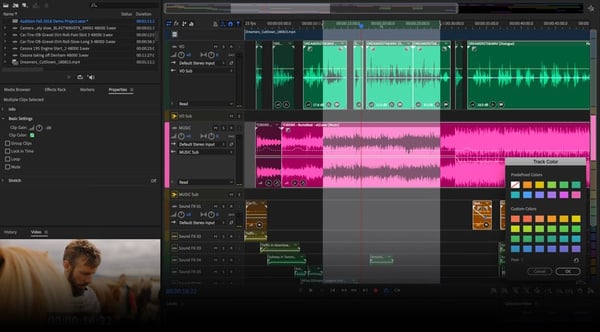
“Adobe Audition is a great tool with a lot of useful features. I have used it for a variety of different projects, and it has always met my needs. Particularly, I like the noise reduction tools to decrease background noise in my audio files within my videos. It also interfaces very well with Premiere Pro.”
- Adobe Audition Review, Nick P.
“Some of the more advanced editing in Adobe Audition can require an experienced ear for how certain effects typically sound. In order to get the most accurate feedback on changes, the user should have professional sound monitors, which can be expensive.”
- Adobe Audition Review, Herb V.
Logic Pro X is Apple's professional-grade audio editing software. It allows users to create and improvise with Live Loops, control music-making sessions from an Apple device, and so much more.
Its long list of features and industry-leading tools make it easy to organize all of your ideas and simplify even the most complex project.
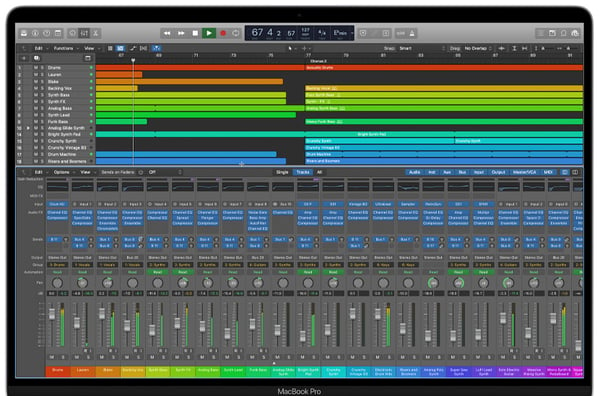
“There are lots of different audio workstations out there today, but I like Logic Pro X because it works on Mac and the tools are very comfortable for me to use. The main area that I work with is the note sequencer, which has very particular spacing and programming capabilities. By default, Logic has many quality sounds and other effects that allow me to make very robust music productions right after it’s installed.”
- Logic Pro X Review, Jeremy C.
“The biggest weakness of Logic Pro X is that it’s not possible to take external VST plugins (the most common format of an audio plugin) and apply it to your current Logic session. This is a considerable weakness from most other commercial DAWs, especially ones in the same price and capability class. This is somewhat mitigated by the fact that Logic comes pre-loaded with a massive suite of instruments, sounds, FX, and plugins that cover many of the bases that external VSTs usually wouldn’t.”
- Logic Pro X Review, Valentin F.
Ableton Live is a fast, fluid, and flexible software for music creation and performance. It comes with effects, instruments, sounds, and all kinds of creative features — everything you need to make any kind of music.
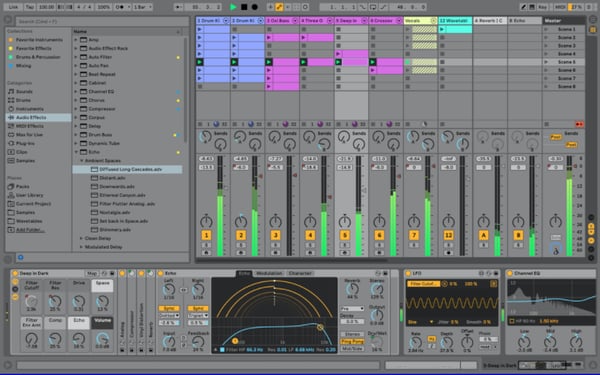
“This software can do absolutely anything from recording, editing, mixing, mastering, midi mapping, and running live backing tracks. It takes a bit to learn, but once you do, you don't need any other music-related software to complete tasks.”
- Ableton Live Review, Winford M.
“The multiple views and layouts of the DAW can be hard to pick up right away. Plus, it takes a while to really grasp all of the features when using this software.”
- Ableton Live Review, Chance M.
GarageBand is Apple's pre-installed OS X music creation tool. With Touch Bar features for MacBook Pro and an intuitive, modern design, it’s easy to learn, play, record, create, and share your audio creations.
Tons of helpful recording and editing features make GarageBand as powerful as it is easy to use.
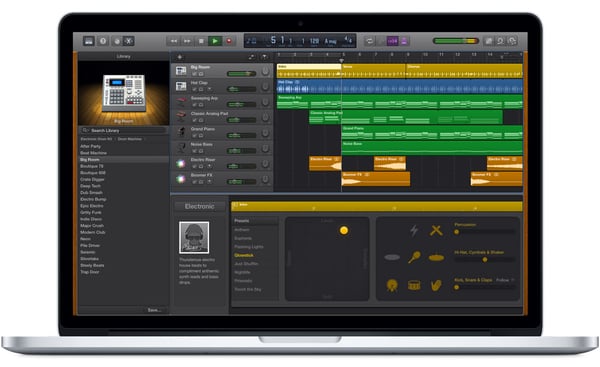
“After using it only a few times, the controls in GarageBand are quite easy to get a hang of. For basic editing, where we cut pieces of audio and move them around, the process is quite intuitive. I like how clips can be instantly cut, and then moved and snapped into place without having to position clips precisely. There are several audio extensions we can use to save our files, which is great when trying to edit and optimize sound for video production.”
- GarageBand Review, Justin T.
“The app's ability to export properly sometimes can be frustrating. Another thing that can be annoying is that you’re limited to using only what is available on Apple's store for plugins and other fun features, like finding different drum samples or guitar tones."
- GarageBand Review, Kyler S.
Audacity is a free and open-source audio editor that’s easy to use, offers a multi-track audio editor and recorder, and works with Windows, macOS, GNU/Linux, among other operating systems.
Users can import, edit, and combine sound files. It’s also simple to export recordings in many different file formats, including multiple files at once.
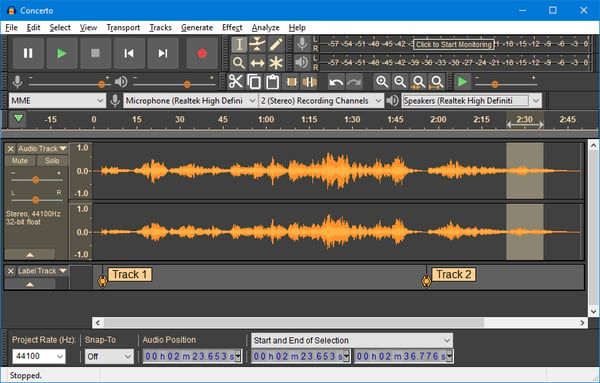
“Audacity is a very user-friendly platform for editing sound clips. I started using it in high school when I did sound design for all our theatre productions and it worked great when I needed to make a sound effect fit a scene or edit out parts of songs. Today, I mainly use it for editing music and it’s very easy to get started with the basics within this program.”
- Audacity Review, Travis B.
“The interface is not the most intuitive. Visually it looks a bit dated and is also not the easiest for finding everything you need. Some of the audio effects may need to be downloaded as additional plugins.”
- Audacity Review, Nick P.
No matter what kind of visual media you’re creating, having an audio description to go hand-in-hand with it is an absolute must. Not only does having an audio description for your content have a long list of benefits, but without one, chances are you’re breaking the law.
At the end of the day, you want as many people to enjoy your content as possible, and in order to do that, you must include those who may be visually impaired.
When you’re ready to record your audio description, learn how easy it is to record audio on a Mac.
Mara Calvello is a Content and Communications Manager at G2. She received her Bachelor of Arts degree from Elmhurst College (now Elmhurst University). Mara writes content highlighting G2 newsroom events and customer marketing case studies, while also focusing on social media and communications for G2. She previously wrote content to support our G2 Tea newsletter, as well as categories on artificial intelligence, natural language understanding (NLU), AI code generation, synthetic data, and more. In her spare time, she's out exploring with her rescue dog Zeke or enjoying a good book.
When I first stepped into Sam Esparza’s sound design class at Scottsdale Community College, I...
 by Sudipto Paul
by Sudipto Paul
Let me tell you a secret: I’m no graphic designer, but I’ve managed to pull off some pretty...
 by Soundarya Jayaraman
by Soundarya Jayaraman
As a marketer and an AI enthusiast, I'm always looking for tools that make creativity faster,...
.png) by Shreya Mattoo
by Shreya Mattoo
When I first stepped into Sam Esparza’s sound design class at Scottsdale Community College, I...
 by Sudipto Paul
by Sudipto Paul
Let me tell you a secret: I’m no graphic designer, but I’ve managed to pull off some pretty...
 by Soundarya Jayaraman
by Soundarya Jayaraman


